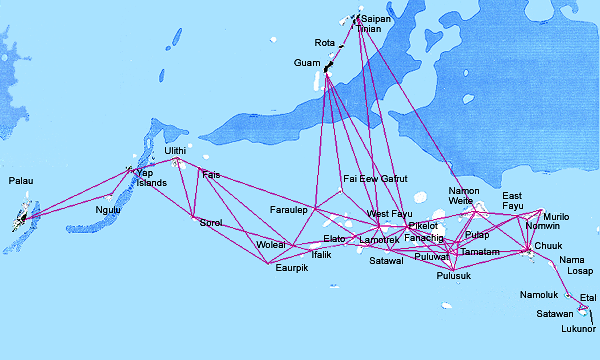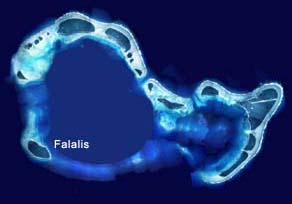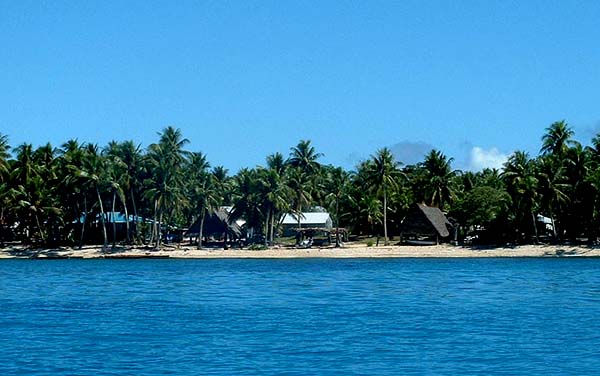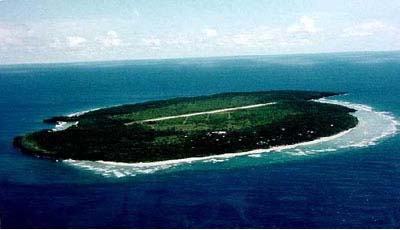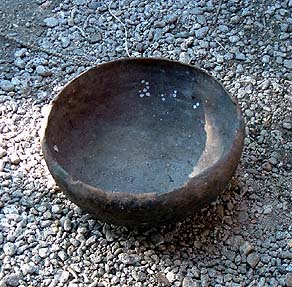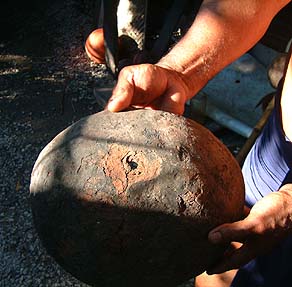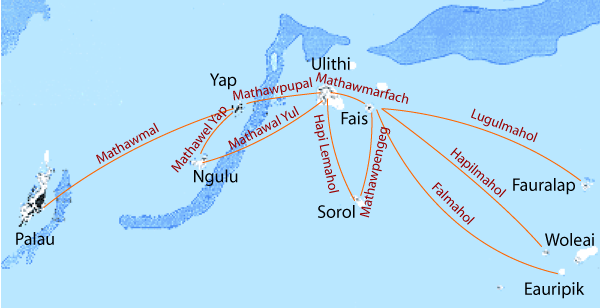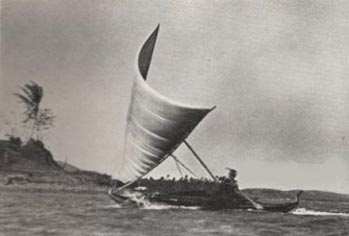|
|
|
|
"The Tribute was done annually," Philip says. "Every year the people in the whole Outer Islands, all the way up to some islands near Chuuk, will make lavalavas, and they will make ropes and they will make all kinds of goods that we bring to Yap. And at certain time of the year, these canoes will sail from those islands all the way down to Fais.
|
||
|
|
||
"Those people from Puluwat, they sail down, because they’re navigators. They’re better than we are. They even go to far distant islands and then they come back to their islands. "Puluwat people will will sail with some valuable collections to Lamotrek. They want to continue because they love to sail, to practice navigation. And they come down to Woleai, and whoever decides to return home, just goes back. But the collection has to be passed down along the chain of command, so that they can see what they can add on top. "From Lamotrek down to Wottagai , and then they come down to Fais. They stay for a few days in Fais, and then they come over here." "If they say the ‘long trip’," Philip explains, "then they will just take their goods to the chief of Fais, and with the goods from Fais, they come to Ulithi, and from Ulithi they take from the chief on Mogmog, and then they go to Yap and give them these tributes. "And if they say, it’s a ‘short trip,’ then the people from Puluwat and those islands near Chuuk will bring their goods to Fais and leave them there, and they go back. And then the navigators of Ulithi will go to Fais and bring those things through to Ulithi, and with the tribute from here, take those on to Yap."
|
||
|
|
||
"When they come over here, they anchor," Stanley continues. "Now when you approach Mogmog, you are supposed to lower down your sail. Put your mast down and then paddle in. You don’t come all the way to the front of any island and then tack. That’s against the culture. It’s disrespectful, and a bad sign. It’s like you’re saying something insulting to the people there. "That’s also why it’s taboo to be standing when you’re approaching an island; you have to sit down. And it’s taboo to wear a mwarmwar when approaching in. If somebody has that on his head, they will just say, ‘oh, that’s a crazy man, he shouldn’t do that.’ |
||
|
|
||
"But there is one island, Falalis in Woleai Atoll, close to Wottagai. On tribute trips only, when their canoe reaches here, the canoe from Falalis island will tack—just once. If they come in on this end, they should change directions. So it tells us, ‘I’m a canoe from Falalis.’ Without their coming ashore to report, we already know, there’s the Falalis canoe, among the canoes." "Everybody else has to put down their sail and paddle in,” Mariano adds, “and are ready to come ashore. Now this Falalis canoe has to a tack, to indicate to the people of here that ‘I am a Falalis canoe, among this fleet here.’ What’s this big deal about Falalis? That question remains.”
|
||
|
|
||
Approaching Mogmog.
|
“Now people here, maybe they expect the fleet, because this is a number of months we wait. It’s not like a ship, just go there, maybe one or two weeks and come back. No; it takes a very long time. They may leave and get hit by bad weather, so that’s more delay. Maybe by the time they get back, they will have lost one or two canoes on the way. “Meanwhile we will put together things within the Atoll, and the Chief of the atoll discusses what we will do. We have associated clans on the other islands in the atoll, and we have to inform them. “In Ulithi, Falalop is our navigator—that’s the navigation island, they should lead the fleet to Yap. So we cannot just decide to sail and then we go without informing Falalop. They should know. That’s given to them by the Chief. They are responsible for that, and we have to honor Falalop. When we go to Yap, then they lead the fleet. When they decide that we should return, then we return. If we happen to get in bad weather, that’s their decision."
|
||
|
|
||
"While the tribute-trip fleet is coming from the farther-out islands, up East, before they even get to Ulithi, the navigators in Falalop should have appointed somebody to be the master navigator of the trip to Yap," Mariano states. "It doesn’t have to be a particular person all the time. The navigators discuss: ‘Now, this year’s trip, who is going to be the Admiral of this fleet, amongst the captains here?’ When somebody is appointed, and then by the time the fleet from the other islands arrives at Ulithi, a captain should have been appointed by then. So when they get to Mogmog, to report the arrival of the whole fleet for the Tribute trip to Yap. "Falalop has their own weatherman," Stanley adds, "they are the best of navigators we ever had in Ulithi Atoll. When they choose and they say that’s right, that’s right! When they predict, a very close prediction they do. The others all depend on them.
|
||
|
|
||
|
|
|
|
“Now all the Ulithi-lagoon canoes,” Mariano says, “they’ll gather along with the rest of the fleet from the Woleai, and the farthest island as far as Puluwat. As they gather, they’ll go out to the island of Fedraey and pull up all the canoes there. It is said that that’s where, the term is called hall'yaeng, meaning ‘we’ll wait for the right time to sail,’ meaning ‘we’re watching out for the right weather now.’ The go-ahead signal still has to made by the master navigator of this fleet. "Of course, he has his own weatherman who observes the weather daily and predicts the coming weather. And this is all done on the island of Fedraey. When every thing is just right, including the weather to set sail, that’s when the master navigator gives the signal, and that’s when they leave Fedraey for Yap." “The reason why they choose Fedraey” Stanley interjects, “is because it’s a little closer to than the rest of the Eastern part of the atoll. So they choose Fedraey to depart from.” “Before they leave Fedraey,” Mariano continues, the master navigator announces the course that they should take. And even on the open sea, the rest of the fleet will be watching his canoe. So whatever tack he makes they have to take that tack.”
|
||
| |
||
|
“In the middle—halfway between Yap and Ulithi—they will stop,” Philip says, “and that navigator from Falalop will tell them what to do, under what star they will sail, and what time they will arrive in Yap; and when they arrive in Yap, will they go in or they wait until day time—it depends on the time that they arrive there.” “Sometime they happen to face bad weather," Stanley points out. "When they face bad weather in the open sea, they have to get the canoes together and tie them together. So they won’t get one away from the rest. So then they wait, float, drifting and waiting, until the storm comes. But they always know. There’s a storm approaching, or there’s a storm is creating so, we may return. We still have time to return. And it will be too risky to continue, because it’s going to be a big one and a strong one. So they return. "And if they think, ‘ah, this is maybe just a cyclone, let's just proceed, just avoid it.’ Maybe they figure the radius of this cyclonic storm, and it’s not that bad, so they are able to continue. But sometimes they get to Yap with one or two lost canoes. They are not with the fleet. What happened? They ended up Manila, and later came back. They always made it back." "So they go all the way down to Yap, Gagil," Mariano
says, "the municipality where the village of Gachpar is located,
where the high chiefs, in relation to the chiefs of Mogmog and the rest
of the allies are connected.
|
||
|
|
||
“When they get to Yap,” Philip says, “then they come to a place where the canoe will land, and they stay there for several days without putting down the mast. They just stand there. They will not do that. Somebody from Yap will come and try to put it down, because they pay him for that, and also if that Yapese who will put down the mast break sit, or it falls down from his hand, they will beat him. “Then they will give out these tributes on a special platform where there are leaning posts for different chiefs from each island. And each chief knows where he belongs on that platform. That’s a meeting place, in Yap, and it’s still there now in Gagil, in Gachpar. Each chief will go and sit down there and the chief of Mogmog will come up and take these goods and say, ‘this one goes to the chief of this part of the Yap, and this one is to ask the chief of Yap to take care of all the children of the Outer Islands when they come to Yap'."
|
||
|
|
||
|
|||||
|
|||||
